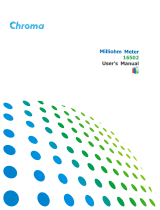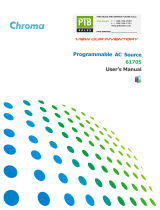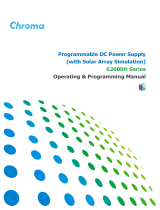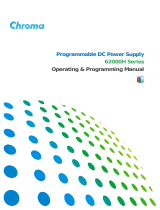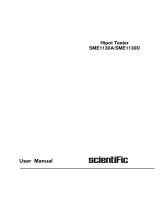Page is loading ...



Multi-Channel Sync Hipot Tester
19020/19020-4/19021/19021-4/
19022/19022-4
User’s Manual
Version 2.3
April 2017

ii
Legal Notices
The information in this document is subject to change without notice.
Chroma ATE INC. makes no warranty of any kind with regard to this manual, including, but
not limited to, the implied warranties of merchantability and fitness for a particular purpose.
Chroma ATE INC. shall not be held liable for errors contained herein or direct, indirect, special,
incidental or consequential damages in connection with the furnishing, performance, or use of
this material.
CHROMA ATE INC.
66 Huaya 1st Road, Guishan, Taoyuan 33383, Taiwan
Copyright Notices. Copyright 2008 Chroma ATE INC., all rights reserved. Reproduction,
adaptation, or translation of this document without prior written permission is prohibited,
except as allowed under the copyright laws.

iii
Warranty
All of Chroma’s instruments are warranted against defects in material and workmanship for a
period of one year from date of shipment. Chroma agrees to repair or replace any assembly
or component found to be defective, under normal use during this period. Chroma’s obligation
under this warranty is limited solely to repairing any such instrument, which in Chroma’s sole
opinion proves to be defective within the scope of the warranty when returned to the factory or
to an authorized service center. Purchaser is responsible for the shipping and cost of the
service item to Chroma factory or service center. Shipment should not be made without prior
authorization by Chroma.
This warranty does not apply to any products repaired or altered by persons not authorized by
Chroma, or not in accordance with instructions furnished by Chroma. If the instrument is
defective as a result of misuse, improper repair, or abnormal conditions or operations, repairs
will be billed at cost.
Chroma assumes no responsibility for its product being used in a hazardous or dangerous
manner either alone or in conjunction with other equipment. High voltage used in some
instruments may be dangerous if misused. Special disclaimers apply to these instruments.
Chroma assumes no liability for secondary charges or consequential damages and in any
event, Chroma’s liability for breach of warranty under any contract or otherwise, shall not
exceed the purchase price of the specific instrument shipped and against which a claim is
made.
Any recommendations made by Chroma regarding the use of its products are based upon
tests believed to be reliable; Chroma makes no warranty of the results to be obtained. This
warranty is in lieu of all other warranties, expressed or implied, and no representative or
person is authorized to represent or assume for Chroma any liability in connection with the
sale of our products other than set forth herein.
CHROMA ATE INC.
66 Huaya 1st Road, Guishan,
Taoyuan 33383, Taiwan
Tel: 886-3-327-9999
Fax: 886-3-327-8898
e-mail: [email protected]
http://www.chromaate.com

iv
Material Contents Declaration
The recycling label shown on the product indicates the Hazardous Substances contained in
the product as the table listed below.
: See <Table 1>.
: See <Table 2>.
<Table 1>
Part Name
Hazardous Substances
Lead
Mercury
Cadmium
Hexavalent
Chromium
Polybrominated
Biphenyls/
Polybromodiphenyl
Ethers
Selected Phthalates
Group
Pb
Hg
Cd
Cr
6+
PBB/PBDE
DEHP/BBP/DBP/DIBP
PCBA
O O O O O O
CHASSIS
O O O O O O
ACCESSORY
O O O O O O
PACKAGE
O O O O O O
“O” indicates that the level of the specified chemical substance is less than the threshold level
specified in the standards of SJ/T
-11363-2006 and EU Directive 2011/65/EU.
“
” indicates that the level of the specified chemical substance exceeds the threshold level
specified in the standards of SJ/T
-11363-2006 and EU Directive 2011/65/EU.
Remarks:
The CE marking on product is a declaration of product compliance with EU
Directive 2011/65/EU.
Disposal
Do not dispose of electrical appliances as unsorted municipal waste, use separate collection
facilities. Contact your local government for information regarding the collection systems
available. If electrical appliances are disposed of in landfills or dumps, hazardous substances
can leak into the groundwater and get into the food chain, damaging your health and
well-being. When replacing old appliances with new one, the retailer is legally obligated to
take back your old appliances for disposal at least for free of charge.

v
<Table 2>
Part Name
Hazardous Substances
Lead
Mercury
Cadmium
Hexavalent
Chromium
Polybrominated
Biphenyls/
Polybromodiphenyl
Ethers
Selected Phthalates
Group
Pb
Hg
Cd
Cr
6+
PBB/PBDE
DEHP/BBP/DBP/DIBP
PCBA
O O O O O
CHASSIS
O O O O O
ACCESSORY
O O O O O
PACKAGE
O O O O O O
“O” indicates that the level of the specified chemical substance is less than the threshold level
specified in the standards of SJ/T
-11363-2006 and EU Directive 2011/65/EU..
“
” indicates that the level of the specified chemical substance exceeds the threshold level
specified in the standards of SJ/T
-11363-2006 and EU Directive 2011/65/EU..
1.
Chroma is not fully transitioned to lead-free solder assembly at this moment; however,
most of the components used are RoHS compliant.
2.
The environment-friendly usage period of the product is assumed under the operating
environment specified in each product’s specification.
Disposal
Do not dispose of electrical appliances as unsorted municipal waste, use separate collection
facilities. Contact your local government for information regarding the collection systems
available. If electrical appliances are disposed of in landfills or dumps, hazardous substances
can leak into the groundwater and get into the food chain, damaging your health and
well-being. When replacing old appliances with new one, the retailer is legally obligated to
take back your old appliances for disposal at least for free of charge.

vi

vii
Unpacking for Check & Inspection
Before shipment, this instrument was inspected and found to be free of mechanical and
electrical defects. As soon as the instrument is unpacked, inspect for any damage that may
have occurred in transit. Save all packing materials in case the instrument has to be returned.
If damage is found, please file claim with carrier immediately. Do not return the instrument to
Chroma without prior approval.
Standard Package
Item Name
Qty
Description
US Power Cord 1
USA standard 180 degree straight head power cord with the
length 1.8 meter, 15A
15A Fuse
2
15A SLOW
CANBUS Cable 1
PHONE CABLE 6P6C to connect multiple devices, length 1
meter
D-SUB Cable 1
D-SUB-25P-MALE*2 to connection multiple devices, length 1
meter
High Voltage Cable
Note 2
Single head high voltage terminal + 20kV high voltage cable,
length 3.1 meters
RTN/LOW Cable
Note 2
Single head BNC(MALE)+RG-174, length 3 meters
Quick Start Guide
2
One English version and one Traditional Chinese version.
User’s Manual CD
1
CD for user’s manuals in English and Traditional Chinese
Note
1. When additional item is required, just inform Chroma the item name.
2. The cable quantity is varied with the output channel configured, for instance,
the cable quantity for 10CH model is 10 sets and for 4CH mode is 4 sets.

viii
Hazard Operation Methods
1. Do not touch the testing area when this Hipot Tester is outputting voltage or you may get
electric shock and it may cause death.
Be sure to obey the following:
․ The earth wire must be connected exactly and use a standard power cord.
․ Do not touch the output terminal.
․ Do not touch the test wire that connected to the terminal in test.
․ Do not touch any unit under test.
․ Do not touch any component that connected to output terminal for charge.
․ Do not touch the test unit right after the test is ended or when the output is just turned
off.
2. The electric shock incident may occur when:
․ The earth terminal of Hipot Tester is not connected properly.
․ The insulating gloves are not in use during test.
․ Users touch the test unit right after the test is done.
Please see Chapter 3 Precaution before Use in this manual for detail
descriptions of usage notices and operation hazards.
Do not tie up the high voltage cable with RS232, Handler and GPIB control
cables or other low voltage side wires. If so, it could cause the product or
PC to be down or damaged.
CAUTION
WARNING

ix
Storage, Freight, Maintenance & Cleaning
Storage
When not in use, please pack the device properly and store in a suitable environment.
Freight
Please pack the device carefully before moving it. If any of the original packing material is
missing, please use suitable alternative material and mark it “fragile” and “keep away from
water” to avoid damaging to the product.
This product is a piece of precision test equipment, so please do not drop or hit it.
Maintenance
In case of any malfunction or abnormality, please refer to the manual, or contact our local
distributor for prompt service. Do not touch any parts inside the instrument to avoid any
danger to yourself or damage to the product.
Regular check and calibration is required to ensure the device meets the product specification.
The suggested calibration period every 12 months.
Cleaning
Remove all connected wires and cables on the instrument before cleaning. Use a brush to
clean the dust on it. For internal cleaning, use a low-pressure air gun to vacuum the dust
inside or send it back to the distributors or agents of Chroma for cleaning.

x
Revision History
The following lists the additions, deletions and modifications in this manual at each revision.
Date
Version
Revised Sections
Nov. 2008
1.0
Complete this manual.
June 2009
1.1
Add “ACA MEAS.” in the section of “Setting SYSTEM CONFIG” under
the chapter of “Operation.”
Update the commands in the chapter of “GPIB/RS232 Interface
(IEEE-488.2).”
Nov. 2009
1.2
Update the values in “Specification” chapter and the figures of
“Example of Using Internal Power Supply” as well as of “Example of
Using External Power Supply” in “Example of External Control Circuit”
section.
June 2010
1.3
Add two new items in the chapter of “Precaution before Use”.
Dec. 2010
1.4
Update “Material Contents Declaration.”
May 2011
1.5
Add descriptions for 19020-4 & 19022-4 two new models.
Sep. 2011
1.6
Update “Standard Package” and its Note in “Unpacking for Check &
Inspection”.
Dec. 2012
1.7
Add “CE Declaration of Comformity”.
Update “Pin Assignment“ in the chapter of “HANDLER Interface”.
Aug. 2013
1.8
Update the following:
– “Setting TEST CONTROL”, “Setting SYSTEM CONFIG” and
“Selecting Test Mode” sections in the chapter of “Operation”
– “Commands Summary” and “Command Description” in the
chapter of “GPIB/RS232 Interface”
Oct. 2014
1.9
Add PSC Mode to DC, IR and OSC tests procedures and commands.
Aug. 2015
2.0
Add descriptions for new model 19021-4.
Mar. 2016
2.1
Modify the following sections:
– “Features” in the chapter of “Preface.”
– Leakage current meter spec. and note description in the chapter
of “Specification.”
– “Front Panel”, “Rear Panel” and “Setting TEST CONTROL” in the
chapter of “Operation.”
– “Commands Summary” and “Command Description” in the
chapter of “GPIB/RS232 Interface.”
– “ACA Current Calibration” and “AC ARC Calibration” in the
chapter of “Calibration Procedure.”
Aug. 2016
2.2
Update “CE Declaration of Conformity”.
Apr. 2017
2.3
Update “Material Contents Declaration” and “CE Declaration of
Conformity”.

Multi-Channel Sync Hipot Tester 19020/19020-4/19021/19021-4/19022/19022-4
User’s Manual
xi
Table of Contents
1. Preface................................................................................................................ 1-1
1.1 Product Overview ........................................................................................... 1-1
1.2 Features ......................................................................................................... 1-1
2. Specification (18
°
C
∼
28
°
C RH
≤
70%) .............................................................. 2-1
3. Precaution before Use ....................................................................................... 3-1
4. Operation ............................................................................................................ 4-1
4.1 Front Panel .................................................................................................... 4-1
4.2 Rear Panel ..................................................................................................... 4-5
4.3 Notices before Using & Procedure ................................................................. 4-6
4.4 Setting SYSTEM Parameters ......................................................................... 4-7
4.4.1 Entering SYSTEM Setting Screen ............................................................ 4-7
4.4.2 Setting TEST CONTROL ......................................................................... 4-8
4.4.3 Setting SYSTEM CONFIG ......................................................................4-10
4.4.4 Setting KEY LOCK ..................................................................................4-11
4.4.5 Setting FAIL LOCK .................................................................................4-12
4.4.6 Changing PASSWORD ...........................................................................4-13
4.4.7 Setting CALIBRATION ............................................................................4-14
4.4.8 Setting ERROR LOG ..............................................................................4-14
4.5 Setting PROGRAM .......................................................................................4-15
4.5.1 How to Get in PROGRAM Setting Screen ...............................................4-15
4.5.2 Setting Program Procedure .....................................................................4-15
4.5.3 Selecting Test Mode ...............................................................................4-16
4.5.4 Description of Parameters .......................................................................4-16
4.6 Managing Memory for Programs ...................................................................4-21
4.6.1 Entering Memory Screen ........................................................................4-21
4.6.2 Saving Memory .......................................................................................4-21
4.6.3 Deleting Memory .....................................................................................4-22
4.6.4 Recalling Memory ...................................................................................4-23
4.7 Using OFFSET or GET Cs ............................................................................4-23
4.7.1 How to Get in OFFSET or GET Cs Screen .............................................4-23
4.7.2 Using GET OFFSET ...............................................................................4-24
4.7.3 Using GET Cs .........................................................................................4-24
4.8 Conducting the Test ......................................................................................4-25
4.8.1 Connecting the UUT ...............................................................................4-25
4.8.2 Procedure for AC/DC Test ......................................................................4-25
4.8.3 Procedure for IR Test ..............................................................................4-26
4.8.4 Procedure for OSC Test ..........................................................................4-27
4.8.5 Test Procedure for PA Test .....................................................................4-28
4.8.6 Auto Range .............................................................................................4-29
4.8.7 Hardware/Software AGC .........................................................................4-29
5. HANDLER Interface ........................................................................................... 5-1
5.1 Introduction .................................................................................................... 5-1
5.2 Specification .................................................................................................. 5-1
5.2.1 Driving Capability ..................................................................................... 5-1
5.2.2 Pin Assignment ........................................................................................ 5-1
5.3 Example of External Control Circuit ................................................................ 5-3
5.3.1 Example of Using Internal Power Supply ................................................. 5-3
5.3.2 Example of Using External Power Supply ................................................ 5-4
5.4 Timing Diagram .............................................................................................. 5-5

Multi-Channel Sync Hipot Tester 19020/19020-4/19021/19021-4/19022/19022-4
User’s Manual
xii
6. GPIB/RS232 Interface (IEEE-488.2) ................................................................... 6-1
6.1 Introduction .................................................................................................... 6-1
6.2 GPIB Interface ............................................................................................... 6-1
6.2.1 Applied Standard ..................................................................................... 6-1
6.2.2 Interface Capability .................................................................................. 6-1
6.2.3 Interface Message ................................................................................... 6-1
6.2.4 Command Format .................................................................................... 6-2
6.2.5 Panel Description ..................................................................................... 6-2
6.3 RS232 Specification ....................................................................................... 6-2
6.3.1 Data Format ............................................................................................. 6-2
6.3.2 Command Format .................................................................................... 6-2
6.3.3 Connector ................................................................................................ 6-3
6.3.4 Connection ............................................................................................... 6-3
6.4 Structure of Remote Interface ........................................................................ 6-4
6.5 Commands for Remote Interface ................................................................... 6-4
6.5.1 Commands Summary .............................................................................. 6-4
6.5.2 Command Description .............................................................................. 6-9
6.6 Error Messages .............................................................................................6-37
7. Calibration Procedure ....................................................................................... 7-1
7.1 Entering Calibration Screen ........................................................................... 7-3
7.2 Selecting the Channel for Calibration ............................................................. 7-3
7.3 A/D REFERENCE Calibration ........................................................................ 7-4
7.4 Voltage Calibration ......................................................................................... 7-4
7.4.1 ACV Calibration ....................................................................................... 7-4
7.4.2 DCV Calibration ....................................................................................... 7-7
7.4.3 OSCV Calibration ..................................................................................... 7-9
7.5 Current Calibration ........................................................................................7-10
7.5.1 ACA Current Calibration ..........................................................................7-10
7.5.2 DCA Current Calibration .........................................................................7-15
7.6 Insulation Resistance (IR) Calibration ...........................................................7-17
7.7 ARC Calibration ............................................................................................7-22
7.7.1 AC ARC Calibration ................................................................................7-22
7.7.2 DC ARC Calibration ................................................................................7-23
7.8 When Calibration is Done..............................................................................7-23

Preface
1-1
1. Preface
1.1 Product Overview
The 19020/19021/19022 Multi-Channel Sync Hipot Testers are high quality devices specially
designed to test the hipot leakage current and insulation resistance automatically for
electrical and electronic equipment.
For withstand voltage test, the output power of each channel for 19020/19020-4 is AC:
50VA(5kV, 10mA) /DC: 30VA(6kV, 5mA), for 19021/19021-4 is AC: 48VA(6kV, 8mA) and for
19022/19022-4 is DC: 28VA(8kV, 3.5mA). Thus they can be used to perform withstand
voltage tests on electronic, electrical equipment as well as on components.
For insulation resistance test, the range it can show is 0.1MΩ ∼ 50GΩ and the test voltage is
50V~1000V that can be set as desired. (Note: Only 19021/19021-4 can conduct AC
withstand voltage test.)
The Hipot Tester uses a clear display to show all settings, time, current, voltage, resistance
and memory channel no., etc. without the need to memorize the parameters set previously.
The Hipot Tester has equipped the device to identify pass or fail products as well as to output
signals of test result and to remote control other devices. It has GPIB, HANDLER and RS232
interfaces that are of advantage to automatic test system. This Tester equipped with assorted
devices mentioned above is capable of performing highly efficient and accurate tests for
electrical, electronic equipment and components.
1.2 Features
■ Sync Withstand Voltage Test
The testers have the world’s first sync withstand voltage test function that a single device
can have 10 channels to output and test simultaneously and maximum 10 devices can
be controlled (master & slave) for 100 channels. They can be grouped for output to avoid
voltage difference from generation due to adjacent test and furthermore to improve the
production efficiency.
■ Multiple Tests
The testers are able to select single test function such as AC withstand voltage test, DC
withstand voltage test, Insulation Resistance (IR) test and Open/Short Check (OSC) test
■ OSC (Open/Short Check)
The testers have built-in OSC function to check if there is any Open (bad connection) or
Short (UUT shorted) occurred during test. It may cause the Fail product to be identified
as Pass if Open occurs. If Short is detected and resolved early when occurred, it can
reduce the damage to fixture and save the test cost.

Multi-Channel Sync Hipot Tester 19020/19020-4/19021/19021-4/19022/19022-4
User’s Manual
1-2
■ Clear Display
The testers have a clearest design for display. All programs for settings such as test
voltage, current state, test readings, test steps and test states are able to be viewed from
the LED display directly.
■ High/Low Limit Comparison for Pass/Fail Products
The testers have been designed to do High/Low Limit comparison for the Unit Under
Test (UUT.) This function is available in Withstand Voltage test or Insulation
Resistance test. The low limit comparison for hipot and high limit comparison for
insulation are used to test if there’s any bad connection or loose test wire that causes
misjudgment.
■ Remote Control
The HANDLER of the testers is able to extend the control signals for controlling
externally. It usually connects to the control box of automated devices.
■ Change Voltage Ramp Time
These testers have a [RAMP] function that can set the time required for voltage rises
from zero to set value.
■ Change Voltage Fall Time
These testers have a [FALL] function that can set the time required for voltage falls from
set value to low when the test time ends.
■ Auto Switch Low Current Range
The current meter ranges for withstand voltage test in the testers have two ranges, one
is low AC range 0~2.999mA and the other is 3.00 mA ~ maximum AC. There are three
ranges for DC: 0~299.9uA low current range, 0.300mA ~2.999mA current range and
3.00~ maximum AC. If the tested current is low, software can be used to switch the
current range to low range automatically for resolution improvement before the test ends
as need.
The 19021 and 19021-4 hipot testers have 4 AC ranges which are 30uA, 300uA,
3.000mA and 8.0mA. If the tested current is low, it can use software to set if
automatically changing the current range to low range before the test ends, so that the
resolution can be increased.

Specification
2-1
2. Specification (18
°
C
∼
28
°
C RH
≤
70%)
Maximum/Model
19020
19020-4
19021
19021-4
19022
19022-4
Output Channels
10CH
4CH
10CH
4CH
10CH
4CH
AC
5kV,10mA
6kV,8mA
-------
DC
6kV,5mA
-------
8kV,3.5mA
IR
1kV
-------
1kV
Multi-hipot unit
Output channels are defined by model, independent output
Frame number
Master fixed the frame number on 0
Slave need to select frame number (1~9)
Withstanding Voltage Test
Output voltage
AC: 0.05-Maximum, steps 0.001kV, 50Hz/60Hz ± 0.1%, sine
wave.
DC: 0.05-Maximum, steps 0.001kV.
Load Regulation: ≤ (1% of setting + 0.1% of full scale),
Rated load, AGC ON
Voltage Accuracy: ± (1% of setting + 0.1% of full scale)
<Note1>
Output voltage monitor
V-monitor: ± (1% of reading + 0.1% of full scale), 2V
resolution
Cutoff current
AC:0.01mA~10mA, 0.001mAdc resolution
DC:0.001mA~5mA, 0.1uAdc resolution
Leakage current meter
AC current:
(30uA and 300uA are only for 19021 and 19021-4)
30uA range: 0.01uA – 29.99uA
<Note 2>
Measurement Accuracy: ±(1% of Reading +2% of full
scale)
300uA range: 0.1uA – 299.9uA
Measurement Accuracy: ±(1% of Reading +2% of full
scale)
3mA range: 0.001mA – 2.999mA
10mA range: 0.01mA -- Maximum;
Measurement Accuracy: ± (1% of setting +0.5% of full
scale)
DC current:
300uA: 0.1uA– 299.9uA
3mA range: 0.001mA – 2.999mA
5mA range: 0.01mA –Maximum
Measurement Accuracy: ± (1% of setting +0.5% of full
scale)
Flashover (ARC)
detection <Note2>
AC: 1mA –20mA, DC: 1mA –10mA, step 0.1mA
Insulation Resistance Measurement
Output Voltage
DC: 0.05-1.0 kV, steps 0.001kV
Voltage Accuracy: ± (2% of setting + 0.5% of full scale)
Output voltage monitor
V-monitor: ± (1% of reading + 0.5% of full scale), 2V
resolution
Measurement accuracy (RH
≤ 60%)
≥500V:
1MΩ~1GΩ: ± (3% of reading + 0.1% of full scale)
1GΩ~10GΩ: ± (7% of reading + 2% of full scale)

Multi-Channel Sync Hipot Tester 19020/19020-4/19021/19021-4/19022/19022-4
User’s Manual
2-2
10GΩ~50GΩ: ± (10% of reading + 1% of full scale)
< 500V:
1MΩ~1GΩ: ± [3% of reading + (0.2 x 500V /Vs)% of full
scale]
Test time
0.03 – 999.9 sec., and Continuous (IR: 0.3 – 999.9 sec.)
Ramp time
0.1– 999.9 sec., and OFF
Fall time
0.1– 999.9 sec., and OFF
OSC – Contact Check
Test voltage level
Less than ac 100V
Test frequency
600Hz
No contact judge
Measured capacitance comparison.
Other functions
Display
320 x 240 dot matrix, blue, LED back light.
Compensation (Correct)
Open circuit
Leakage current offset compensation for WVAC, WVDC,
and IR testing
PASS/FAIL System
Indication, alarm
PASS : (Short Sound)
FAIL : High/Low Fail (WV, IR)
ARC Fail (WV)
Open/Short Fail (OSC)
System Error
Memory Storage
Save/Recall
30 instrument setups with up to 10 test steps can be stored
into and recalled from the internal memory.
Key lock
Front panel keys can be locked to prevent undesired
operation.
Interface
GPIB (Standard)
Complies with tested values and comparator decision results
can be stored and output.
RS232 (Standard)
Standard: RS232, The programming language is SCPI.
Data buffer: One set of tested IEEE488.1 and 488.2. The
programming language is SCPI.
Data buffer: One set of values and comparator decision
results can be stored and output.
Handler interface (Standard)
Judge result (O/P)
Output channels Pass/Fail, Total Pass/Fail (Lo: Pass , Hi:
Fail)
nEOT: Low active
Control signal
Start trigger (I/P): Falling edge trigger.
Stop Testing (I/P): Falling edge trigger.
Memory recall(I/P): 7 sets
Power supply
Internal
+Vint: 5V, 40~60mA limit current.
Common Int.
External
+Vext: +3V~+26V allowable.
Common Ext.
Indication, alarm
PASS(short Sound)
FAIL: High, Low, ARC, System Error(Long Sound)

Specification
2-3
Interlock
2 pins connector, pin1 pull-up to digital +V source with
4.7kohm resistor, and pin 2 tied to digital GND.
Ambient Temperature and Relative Humidity
Specifications range
18 to 28°C (64 to 82°F), ≤ 70% RH.
Operable range
0°C to 45°C, 15% to 95% RH@ ≤ 40°C and no
condensation.
Storage range
-10 to 60°C (-14 to 140°F), ≤ 80% RH.
Power Requirement
Line voltage
AC 100V~240V±10%
Frequency
47~63 Hz
Power consumption
Standby: < 250W
With rated load: <1100W
Dimension
428 W x 174 H x 600 D mm
Weight
Approx. 40kg
Safety
Ground bond
Less than 100mΩ at 25Amp, 2sec
Hi-Pot L + N to Earth
Less than 10mA at WVAC 1.5kV, 60Hz, 3sec no flashover
happen (ARC level < 8mA, tested by Chroma 19032)
Insulation L + N to Earth
Greater than 20MΩ at 500V dc, 2 sec.
Line Leakage Current
Less than 3.5mA at Vin max (132V at 120V selected
voltage), normal and reverse.
Note
1. When the testing time is less than 0.3 second, the output voltage specification is
±(4% of setting + 0.2% of full scale)
It is necessary to calibrate again when the high voltage module on the rear
panel is replaced.
2. The accuracy of 30uA range is only valid for capacitive load.
3. AC ARC Validation point is 1.25kV with a 250kΩ resistor.
DC ARC Validation point is 1.50kV with a 500kΩ resistor.

/

